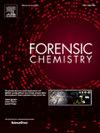Instrumental color determination of local soils and its variation with elemental profiles
IF 2.6
3区 医学
Q2 CHEMISTRY, ANALYTICAL
引用次数: 0
Abstract
Forensic soil comparison typically relies on qualitative color description through visual observation and side-by-side comparison with standard color chips from the Munsell Soil Color Charts to determine a color notation. Soil color distinctions are then made according to the US National Soil Survey color contrast classes. However, this approach is inherently subjective due to the variations in human examiner’s color perception, which is further influenced by factors such as light intensity, viewing angle, and background contrast. Conversely, color-measuring instruments like spectrophotometers can detect subtle color variations reliably and with greater precision, including colors falling between the chips in Munsell Soil Color Charts. Color differences between a soil pair can be expressed numerically as and a threshold based on to distinguish soil colors can be established for objective color comparison. In this study, the colors of soils collected from Singapore parks (soils sampled from areas within 1 m, within the same park, and across different parks) were measured quantitatively using a spectrophotometer. The occurrences of false positives and negatives were calculated and evaluated for the visual and instrumental color comparison methods. We further investigated correlations between the color discrimination threshold based on and a previous survey conducted on local soil’s elemental variability. The outcome of this study will help streamline soil analysis workflows in laboratories and strengthen the interpretation of forensic comparison of local soils.

当地土壤颜色的仪器测定及其随元素剖面的变化
法医土壤比较通常依赖于通过视觉观察和与蒙塞尔土壤颜色图中的标准颜色芯片并排比较来定性描述颜色,以确定颜色符号。然后根据美国国家土壤调查颜色对比等级进行土壤颜色区分。然而,这种方法本质上是主观的,因为人类审查员的颜色感知存在差异,这进一步受到光强度、视角和背景对比度等因素的影响。相反,像分光光度计这样的颜色测量仪器可以可靠地、更精确地检测到细微的颜色变化,包括在孟塞尔土壤颜色图中落在芯片之间的颜色。土壤对之间的色差可以用数值表示为ΔE00,并基于ΔE00建立区分土壤颜色的阈值,进行客观的颜色比较。在本研究中,使用分光光度计定量测量了从新加坡公园收集的土壤的颜色(从1 m范围内,同一公园内和不同公园之间取样的土壤)。假阳性和阴性的发生计算和评估视觉和仪器颜色比较方法。我们进一步研究了基于ΔE00的颜色识别阈值与先前对当地土壤元素变异性的调查之间的相关性。本研究的结果将有助于简化实验室的土壤分析工作流程,并加强对当地土壤法医比较的解释。
本文章由计算机程序翻译,如有差异,请以英文原文为准。
求助全文
约1分钟内获得全文
求助全文
来源期刊

Forensic Chemistry
CHEMISTRY, ANALYTICAL-
CiteScore
5.70
自引率
14.80%
发文量
65
审稿时长
46 days
期刊介绍:
Forensic Chemistry publishes high quality manuscripts focusing on the theory, research and application of any chemical science to forensic analysis. The scope of the journal includes fundamental advancements that result in a better understanding of the evidentiary significance derived from the physical and chemical analysis of materials. The scope of Forensic Chemistry will also include the application and or development of any molecular and atomic spectrochemical technique, electrochemical techniques, sensors, surface characterization techniques, mass spectrometry, nuclear magnetic resonance, chemometrics and statistics, and separation sciences (e.g. chromatography) that provide insight into the forensic analysis of materials. Evidential topics of interest to the journal include, but are not limited to, fingerprint analysis, drug analysis, ignitable liquid residue analysis, explosives detection and analysis, the characterization and comparison of trace evidence (glass, fibers, paints and polymers, tapes, soils and other materials), ink and paper analysis, gunshot residue analysis, synthetic pathways for drugs, toxicology and the analysis and chemistry associated with the components of fingermarks. The journal is particularly interested in receiving manuscripts that report advances in the forensic interpretation of chemical evidence. Technology Readiness Level: When submitting an article to Forensic Chemistry, all authors will be asked to self-assign a Technology Readiness Level (TRL) to their article. The purpose of the TRL system is to help readers understand the level of maturity of an idea or method, to help track the evolution of readiness of a given technique or method, and to help filter published articles by the expected ease of implementation in an operation setting within a crime lab.
 求助内容:
求助内容: 应助结果提醒方式:
应助结果提醒方式:


